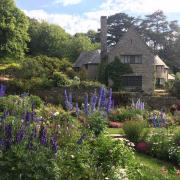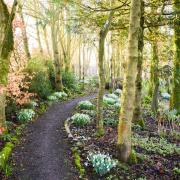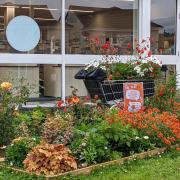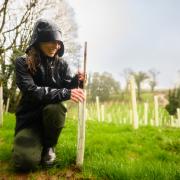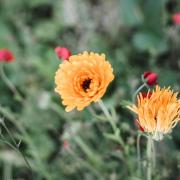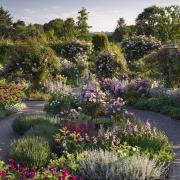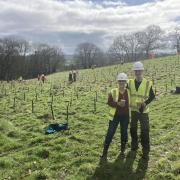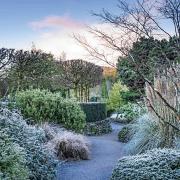Devon varieties of fruits and vegetables are being rediscovered thanks to a thriving seed swapping movement says Helen Stiles
Multi-coloured carrots, purple-podded peas and beans and striped tomatoes - the varieties in the vegetable plots of our great-grandparents' days would have been a psychedelic feast for the eyes. Over the last century, we have lost nearly 90% of our vegetable varieties; many have fallen victim to EU bureaucracy since the 1970s, which demands that each country has a common catalogue, the National List. To qualify, a crop must be tested for distinctness, uniformity and stability; this costs thousands of pounds so non-commercial varieties have been frozen out.
Why bother with the 'has beens' of the vegetable plot? The simple answer is choice and taste. Our choices in the 21st century are severely reduced; out of 120 varieties of tall garden pea, only a handful remain and yet these taller peas are out of the reach of slugs and easier for us to pick, so why ditch them?
Neil Munro of the Heritage Seed Library (HSL), explains: "These days all peas are small or dwarf varieties so they can be harvested with a combine and they all ripen at the same time." Tomatoes are another example Neil uses. "Up until the '40s and '50s there was a thriving local market garden culture, long-distance transport and shelf life didn't matter, so the tomato's flavour could be top priority, rather than a thick skin and long sell by date."
'Auntie Madge's Tomato', 'Uncle Fred's Pea' and 'Mr Stiff's Bunching Onions' are just three of 800 or so rare heritage varieties saved by the Heritage Seed Library. HSL is part of Garden Organic, formerly the Henry Doubleday Research Association, which has been at the forefront of the organic horticulture movement for the last 50 years. HSL's Seed Search programme, last held in 2000, preserved regional, family and historic varieties saved over many generations, explaining the unusual names that crop up. Some, like the 'Lazy Housewife' climbing French bean and the 'Drunken Woman' lettuce, leave one wondering!
Victorian gardeners could select varieties to extend a season or to suit the local climate. Being able to choose varieties for their planting and ripening times gives us more chance of a successful crop - important now, in the climate-change garden's uncertain weather conditions. Locally grown plants also give an advantage, as Neil explains: "Over time, you acclimatise a plant to the local conditions, so after four or five years seeds from that plant will be well adapted to your area. Most conventional seed is bulk-grown in Africa or Italy, so seed swaps are an ideal place to find locally grown seeds."
Because most heritage varieties are not on the 'list' they cannot be bought or sold, so the HSL offers its 11,000 members up to six packets of seeds chosen from a rolling list of around 200 varieties. You may also come across heritage seeds that grow well locally at a seed swap, where you can traffic in 'outlaw seeds' - because it's illegal to sell seeds that aren't on the National List.
The first UK seed swap was held at a church hall in Kemptown, Brighton, in 2002. A couple of members from the Brighton and Hove Organic Garden Group had visited a well-established seed swap event in Vancouver and were so inspired by what they saw that they brought the idea back home. Now the Brighton and Hove Seedy Sunday is the UK's biggest community seed swap, with over 1,200 people rummaging through boxes filled with seeds from dozens of traditional varieties of garden vegetables that thrive on the south coast.
"It's grown into quite an event," says Vicki Williams, one of the organisers. "The seed swap table is the main focus, there are 40 or so stalls demonstrating seed saving and growing, a Seed Potato stall that sells over 100 different varieties, a Seed Doctor and a Compost Doctor." As well as having a good time, there is a serious message to put across. "Community seed swaps are vital," says Vicki. "This legislation was originally brought in to protect the quality of seeds, but now the only seeds on that list are those that are good for commercial growing, so diversity, taste and local growing conditions do not come into it."
Underground dealing in outlawed seeds has now spread to North and South Devon. Julian Vayne and his partner, Helen Gray, worked on the first Seedy Sunday in Brighton and transplanted the idea to Bideford when they moved there six years ago. From humble beginnings, the event has burgeoned: last year Carol Klein and a film crew from BBC's Gardeners' World joined hundreds of keen seed swappers at the North Devon seed swap.
The Bideford swappers have found a few local varieties themselves. "Someone brought in a very tall blackcurrant bush, we'd never seen a variety like it before," says Julian. "It appears to be indigenous to North Devon. We also saved an heirloom tomato; someone brought seeds in to swap a few years ago, they subsequently lost their seeds but managed to get them back via the seed swap, so it works as a collective local seed bank. Having so many different varieties really does make our gardens much more resilient to climate change."
Across the county, the Seedy Sisters, part of the Transition Town Totnes Food Group, are into their third year of seed swaps. Botanist Dr Carol Wellwood, a founding member, says: "To grow our own food in a resource-scarce world, we need those local varieties and that local knowledge for our future. Seed swaps enable the much older gardeners, who have the wisdom of growing food without all the modern chemicals and fertilisers, to pass on that information to a younger generation."
The Seedy Sisters have adopted Devon varieties through the HSL scheme - including a 6ft-tall pea, 'Glory of Devon', which won the RHS merit award in 1889, and 'Veitch's Autumn Giant', a large, slow-growing cauliflower.
The name Veitch rings through the history of British fruit and vegetable varieties, particularly in Devon. The Veitch family's very successful nursery in Exeter bred hundreds of varieties of fruit and vegetables, and distributed some of the great vegetables of the day, including the classic King Edward potato.
Horticulturist Caradoc Doy is an authority on Veitch. "We're still living with the legacy of Veitch and other leading nurserymen of that golden age who created all these wonderful varieties for the table. There was huge demand in market gardens for bigger, fatter, tastier, disease-resistant fruit and vegetables, just like today, though we use more controversial methods such as GM production."
Sadly only a handful of Veitch's tasty legacy remains including 'Veitch's Red Globe' turnip, 'Veitch's Western Express' pea and 'Veitch's Climbing Bean', which at one time was the most widely grown French bean in England. Gone forever are the 'Golden Gem' gooseberry, 'Veitch's Scarlet Model' carrot, 'Veitch's Splendid Curled' parsnip and the 'Tom Cobleigh' potato: the roll call of the lost goes on and on.
Caradoc would like to create a vegetable garden typical of the period, full of those lost Veitch varieties. He's already had a lucky find in a local garden: "I came across a 'Veitchberry'. It tastes like a raspberry but looks like a blackberry and fruits at the same time as a blackberry. I'm now growing a few plants on so I can reintroduce it."
With such a delicious delights as that nearly slipping through our fingers, it's down to us to make sure that we don't lose our unique Devon varieties, even if the seeds we sow are outlaws;





